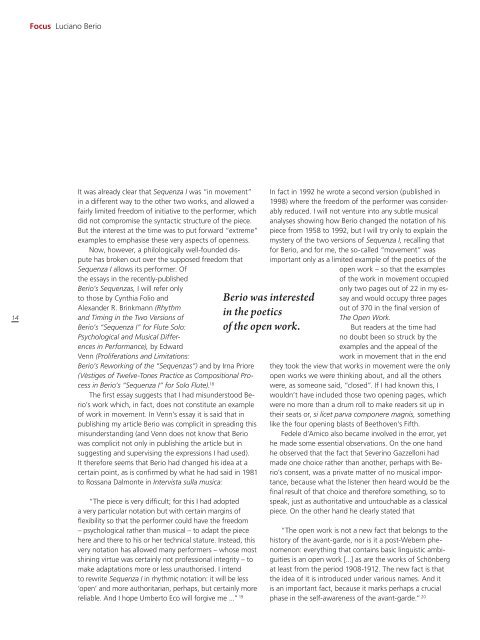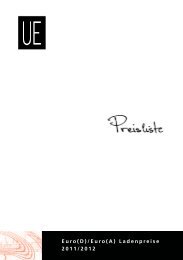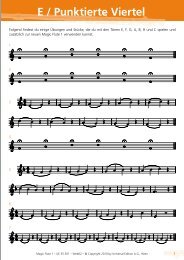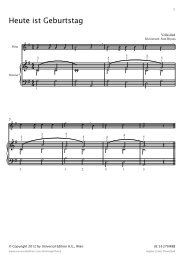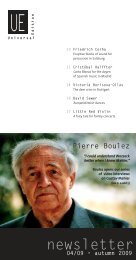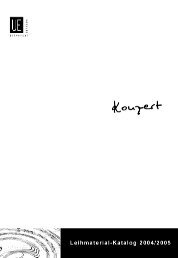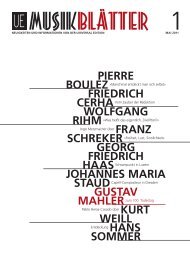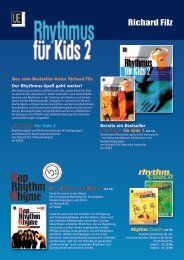Download a PDF file - Universal Edition
Download a PDF file - Universal Edition
Download a PDF file - Universal Edition
Create successful ePaper yourself
Turn your PDF publications into a flip-book with our unique Google optimized e-Paper software.
14<br />
focus Luciano Berio<br />
It was already clear that Sequenza I was “in movement”<br />
in a different way to the other two works, and allowed a<br />
fairly limited freedom of initiative to the performer, which<br />
did not compromise the syntactic structure of the piece.<br />
But the interest at the time was to put forward “extreme”<br />
examples to emphasise these very aspects of openness.<br />
Now, however, a philologically well-founded dispute<br />
has broken out over the supposed freedom that<br />
Sequenza I allows its performer. of<br />
the essays in the recently-published<br />
Berio’s Sequenzas, I will refer only<br />
to those by Cynthia Folio and<br />
Alexander R. Brinkmann (Rhythm<br />
and Timing in the Two Versions of<br />
Berio’s “Sequenza I” for Flute Solo:<br />
Psychological and Musical Differences<br />
in Performance), by Edward<br />
venn (Proliferations and Limitations:<br />
Berio’s Reworking of the “Sequenzas”) and by Irna Priore<br />
(Vèstiges of Twelve-Tones Practice as Compositional Process<br />
in Berio’s “Sequenza I” for Solo Flute). 18<br />
The first essay suggests that I had misunderstood Berio’s<br />
work which, in fact, does not constitute an example<br />
of work in movement. In venn’s essay it is said that in<br />
publishing my article Berio was complicit in spreading this<br />
misunderstanding (and Venn does not know that Berio<br />
was complicit not only in publishing the article but in<br />
suggesting and supervising the expressions I had used).<br />
It therefore seems that Berio had changed his idea at a<br />
certain point, as is confirmed by what he had said in 1981<br />
to Rossana Dalmonte in Intervista sulla musica:<br />
“The piece is very difficult; for this I had adopted<br />
a very particular notation but with certain margins of<br />
flexibility so that the performer could have the freedom<br />
– psychological rather than musical – to adapt the piece<br />
here and there to his or her technical stature. Instead, this<br />
very notation has allowed many performers – whose most<br />
shining virtue was certainly not professional integrity – to<br />
make adaptations more or less unauthorised. I intend<br />
to rewrite Sequenza I in rhythmic notation: it will be less<br />
‘open’ and more authoritarian, perhaps, but certainly more<br />
reliable. And I hope Umberto Eco will forgive me ...” 19<br />
Berio was interested<br />
in the poetics<br />
of the open work.<br />
In fact in 1992 he wrote a second version (published in<br />
1998) where the freedom of the performer was considerably<br />
reduced. I will not venture into any subtle musical<br />
analyses showing how Berio changed the notation of his<br />
piece from 1958 to 1992, but I will try only to explain the<br />
mystery of the two versions of Sequenza I, recalling that<br />
for Berio, and for me, the so-called “movement” was<br />
important only as a limited example of the poetics of the<br />
open work – so that the examples<br />
of the work in movement occupied<br />
only two pages out of 22 in my es-<br />
say and would occupy three pages<br />
out of 370 in the final version of<br />
The Open Work.<br />
But readers at the time had<br />
no doubt been so struck by the<br />
examples and the appeal of the<br />
work in movement that in the end<br />
they took the view that works in movement were the only<br />
open works we were thinking about, and all the others<br />
were, as someone said, “closed”. If I had known this, I<br />
wouldn’t have included those two opening pages, which<br />
were no more than a drum roll to make readers sit up in<br />
their seats or, si licet parva componere magnis, something<br />
like the four opening blasts of Beethoven’s Fifth.<br />
Fedele d’Amico also became involved in the error, yet<br />
he made some essential observations. on the one hand<br />
he observed that the fact that Severino Gazzelloni had<br />
made one choice rather than another, perhaps with Berio’s<br />
consent, was a private matter of no musical importance,<br />
because what the listener then heard would be the<br />
final result of that choice and therefore something, so to<br />
speak, just as authoritative and untouchable as a classical<br />
piece. on the other hand he clearly stated that<br />
“The open work is not a new fact that belongs to the<br />
history of the avant-garde, nor is it a post-Webern phenomenon:<br />
everything that contains basic linguistic ambiguities<br />
is an open work [...] as are the works of Schönberg<br />
at least from the period 1908-1912. The new fact is that<br />
the idea of it is introduced under various names. And it<br />
is an important fact, because it marks perhaps a crucial<br />
phase in the self-awareness of the avant-garde.” 20


